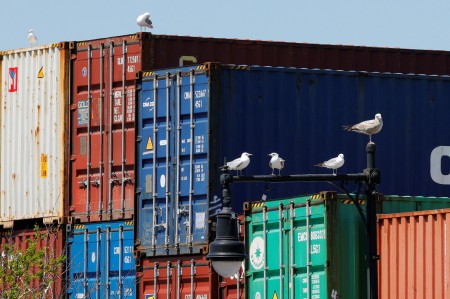By Lisa Baertlein
LOS ANGELES (Reuters) – A threatened Oct. 1 strike by dockworkers at ports on the U.S. East Coast and Gulf of Mexico would immediately disrupt the flow of goods in the country, the North America chief executive of French container carrier CMA CGM said on Wednesday.
The International Longshoremen’s Association union represents 45,000 workers at 36 ports including New York/New Jersey, Houston and Savannah, Georgia. The union has vowed to stop work if it does not have a new labor agreement in place when the current six-year contract expires on Sept. 30 at midnight.
“The moment you close the door, things begin to back up,” George Goldman, CMA CGM’s North America chief, said on a webcast hosted by the Port of Los Angeles.
“One day is too long” for port closures, he said.
CMA CGM is a member of the United States Maritime Alliance employer group that is negotiating with the ILA.
The ports that stand to be affected handle about half of U.S. imports. Worried retailers, manufacturers and other ocean shippers have been shifting some cargo to the West Coast to cut the chance of having cargo stuck at idled facilities.
Analysts at Sea-Intelligence, a Copenhagen-based shipping advisory firm, estimate it could take anywhere from four to six days to clear the backlog from a one-day strike.
A two-week strike could mean that ports would not return to normal operations until 2025, Sea-Intelligence said.
Goods from Europe, India and other countries that rely on direct routes across the Atlantic Ocean would be most heavily affected, transportation experts said.
Meanwhile, imports to the busiest U.S. West Coast ports are surging.
That is because customers of CMA CGM, Maersk and other large container carriers also have been rushing in stocks of Halloween costumes and Christmas apparel before any potential labor action. At the same time, manufacturers have been loading up on solar panels and other goods targeted for potential tariff increases.
The Port of Long Beach in August notched the busiest month in its 113-year history, with volume jumping nearly 34% from the year earlier, bolstered by a 40% surge in imports.
The neighboring Port of Los Angeles reported an August volume jump of 16%, fueled by a nearly 18% jump in imports.
Gene Seroka, executive director for the Port of Los Angeles, said the bump from cargo shifts from other ports is hard to quantify. Still, he said Los Angeles can handle about 1.2 million 20-foot equivalent units per month, versus the 960,597 TEU processed in August.
“We can handle this cargo,” Seroka said.
(Reporting by Lisa Baertlein in Los Angeles; Editing by Matthew Lewis)













